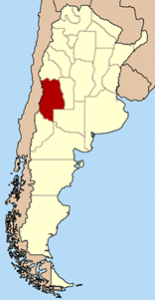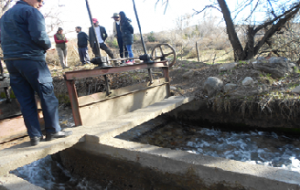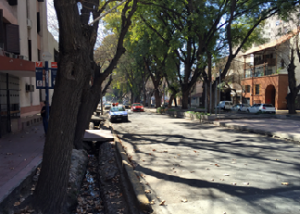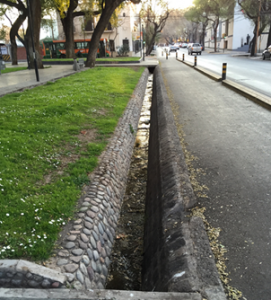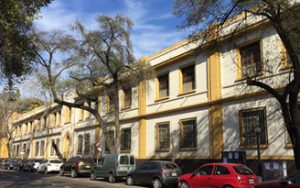Nicolás Pineda
I am in the City of Mendoza, in the Mendoza Province of Argentina. As a member of a network of scientists interested in water governance in arid regions, I periodically attend meetings that take place in different countries. This year, the meeting is in this city, and in this blog, Adriana and I will tell you about our first impressions.
The city
Mendoza is located at the foot of the Andes Mountains, very far from Buenos Aires and close to the City of Santiago, in Chile, with the Andes Cordillera in between. In fact, the city emerged as a stop of the trading route before crossing the cordillera into Chile. It rains very little, about 200 mm a year (in my hometown – Hermosillo, Sonora, Mexico – it rains 300 mm a year) and the natural landscape is arid. The climate also tends to be hot, although not as hot as Sonora. However, the province is crossed by several mighty rivers fed by the melting of the glaciers in the Andes cordillera. These rivers have favored the creation of what they call “oasis” in which there has been a prosperous development of wine industry. There are about 250,000 hectares of vineyards in this area.
It is here that the Malbec Argentinean wines are produced. It attracts my attention the good planning that this city shows and the five plazas distributed throughout the center of the city; a great central plaza in the core area and four in the peripheries. They have explained to me that the city planning dates back to 1862, when the city was reconstructed after a strong earthquake destroyed most of the city and killed half of its population. This is the purpose of the plazas – these are places where refugee centers can be located whenever another earthquake occurs. In addition, the city is filled with trees including eucalyptus, algarrobas (that is how they refer to mesquite trees here) and other species. In order to irrigate these trees, the sidewalks have been equipped with canals called acequias, through which all of the trees in the city are periodically irrigated.
The city had 850 thousand inhabitants in 2009, which make this city very similar in size to Hermosillo. Its population is composed mainly of Spanish and Italian immigrants. This is reflected in the local gastronomy, in which the empanada (a pastry filled with ground meat) seems to be the main dish. It is very interesting that all the time I have spent here, I have encountered that the menus in the restaurants are composed of multiple kinds of pastries and bread, but very few salads and vegetables. Breakfast: mate (local tea) with bread. Lunch: empanadas, pizza or lasagna with wine or soft drinks. Dinner: a traditional beef stew with corn, similar to our Mexican pozole, but here named “locro.”
Water in the province
Our host in this city is the Departamento General de Irrigación (General Irrigation Department), headed by the Water Superintendent. It draws my attention that, contrary to Mexico, in Argentina water is owned and managed by the provincial governments. The federal government is not involved in water management and all the water affaires are handled at the state level. The Water Superintendent is proposed by the governor and approved by the legislative body for a five-year period, without possibility of re-election. Because the governor only lasts four years and is not re-elected either, the periods of the governor and the superintendent do not coincide. This off timing in the elections gives a great power and autonomy to the superintendent. His/her power is strengthened because they raise their own budget.
Another aspect that called my attention is that, even though water in this country is also considered public property, water allocations, at least in this province, are linked to land ownership, or land titles. Whoever owns agricultural land has water rights in the same proportion as the size of the land. This is something I see differs greatly from the way we allocate water in Mexico. Here, in Mendoza, land ownership is also a water right.
Adriana Zúñiga
This is the first time I visit Argentina and I am thrilled to be in such a beautiful country, so far away from home. I particularly loved looking at the Andes Mountains as we flew over from Santiago, Chile. It is hard to adjust my mind to the fact that it is winter in this side of the world, when it was 112°F when I left home in Tucson, Arizona a week ago. Just packing a winter coat in the Tucson heat felt very strange! But I am glad I have a coat with me in Mendoza.
Tall trees from another climate
My second impression of this city is that it looks like a city in a temperate-humid climate and not a city in an arid region. As the plane descended in Mendoza, I could see that the landscape was very similar to Arizona. It is a dryland, but without the saguaros. However, as the driver from the Departamento General de Irrigación drove us from the airport into the city, the landscape suddenly transformed into a landscape you would find somewhere else, but not in the desert. Most of the streets have tall trees on both sides, perfectly aligned and about the same age. The trees must be many decades old and although some do not have leaves at the moment (because of the winter season), they still cover the streetscape with their beautiful organic embrace.
Trees were the feature in this city that attracted my attention the most and the reason is simple. I have been studying greenspace in cities for several years. I did my dissertation on the human use of greenspace and learned about the wellbeing benefits of greenspace, particularly trees. But having tall trees in cities in arid lands is a big challenge, because water is a limiting factor for the growth and survival of trees. How do they manage to grow these many trees in the desert?
As I was looking out of the window from the car, I was thinking that perhaps people in Mendoza maximized their rainfall for the benefit of trees and directed stormwater to green areas. This technique of rainwater harvesting is sometimes referred to as “green infrastructure” and in Tucson there is a big trend towards this practice. But as I tried to identify familiar rainwater harvesting techniques, I noticed that there were narrow canals along both sides of the street, between the tree line and the road. The canals were paved, which meant that there is no water infiltration going on. This is contrary to the principles of green infrastructure. Why would they do this? Was this the way their stormwater infrastructure was laid out – open narrow canals along the streets? I was very intrigued.
In the subsequent days attending the workshop on water governance I understood the reason behind the beautiful trees of Mendoza. The melting of the glaciers in the Andes provide an abundant and relatively secure water source for the region. The Departamento General de irrigación, the water agency of the province, allocates a certain amount of water for “recreational use” and this includes the irrigation of trees, green areas in plazas, and parks. So they periodically irrigate all the greenspace of the city in a controlled and efficient way – they open a certain gate upstream for a specific length of time and water runs throughout all the canals (called acequias) in the city reaching every tree. This is really astounding!
Our gracious hosts, Facundo Martín and Paula Mussetta from CONICET – the research institution of Argentina – knowing my passion for greenspace in cities – kindly gave me a book on the acequias of Mendoza as a gift that is now a treasure in my small-but-growing library. In a subsequent blog, I will share with you what I learned from this fascinating irrigation system in Mendoza.
Architecture
My second impression of Mendoza is that there is an architectural mismatch in the sense that its architecture does not match its history. I have a background in architecture and I teach courses on the History of the Built Environment at the University of Arizona, so I enjoy looking at buildings and learning about them. Before arriving to Mendoza, I had read that indigenous people – the Huarpes, Incas, and Puelches – have inhabited this land for many years before the Spaniards conquered them in the 16th century and named the city – Mendoza – after the governor of Chile. Because my home country – Mexico – share a common history of European (Spanish and Portuguese) colonialism with the rest of Latin America, I expected to find similar buildings to Mexico. I was expecting to see baroque/churrigueresque and neoclassic architecture, for example, and of course, modern buildings. However, as we drove throughout Mendoza and walked its beautiful streets, I struggled to find buildings that were more than 100 years old. After talking to our local colleagues I learned the reason behind the lack of old buildings – earthquakes. As Nicolas mentioned above, there was a devastating earthquake in the late 19th century that destroyed most of the city, and with it, its architectural heritage. Mendoza is located in an important seismic zone, right in the convergence of two tectonic plates. So earthquakes occur frequently in this region.
Another architectural design feature that caught my attention was the proliferation of window shutters. Most buildings have some type of shutter to protect their windows, similar to those used in buildings along the coasts that are vulnerable to hurricanes. But Mendoza is not close to the ocean, so why would they use shutters? I asked around and I found out that Mendoza is prone to experience dust storms that can sometimes be very strong. Therefore, the local architecture has been adapted to its climate and its frequent severe dust storm events.
Fortunately, we did not experience any dust storm or earthquakes while we attended the water governance workshop and I enjoyed my time in Mendoza very much. I rejoiced to see its wonderful albeit not-so-old buildings, walk its walkable streets, and feel its vibrant community. Most importantly, I got the opportunity to meet very smart, kind, and warm people that now I consider my friends.
Colegio Maria Auxiliadora – Neoclassic building in Mendoza remodeled in 1934 and equipped with shutters to protect windows from dust storms


